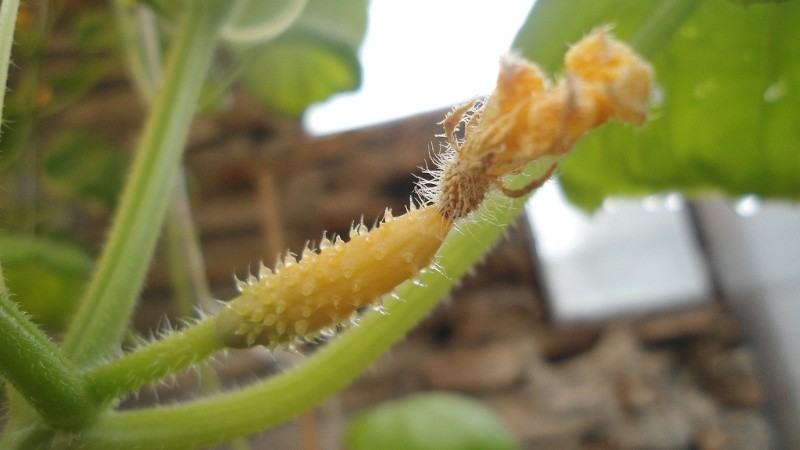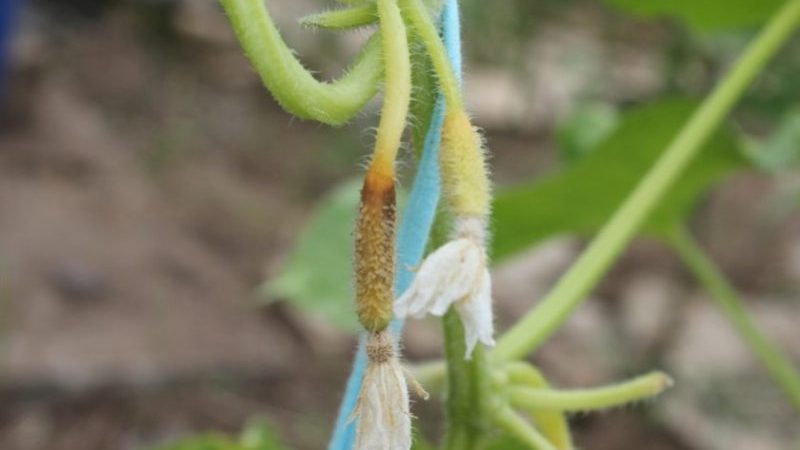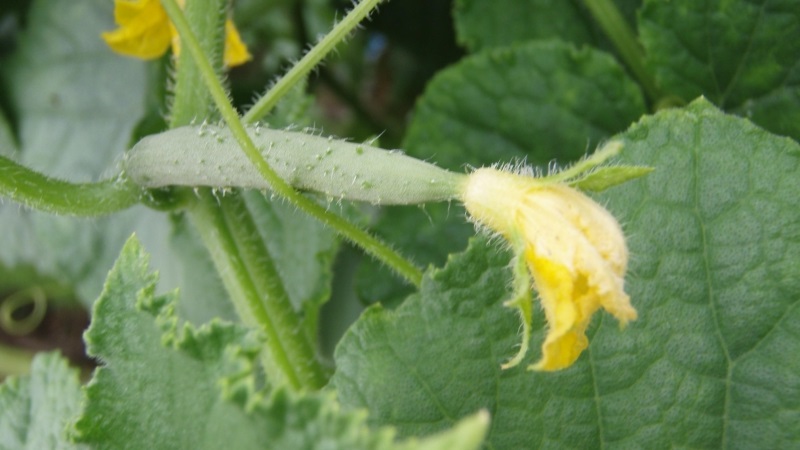What to do if cucumber ovaries turn yellow in the greenhouse
Cucumbers are often grown in polycarbonate greenhouses, and many gardeners are faced with the problem of yellowed ovaries. There are many reasons why the ovaries turn yellow. Therefore, before planting cucumbers in the greenhouse, you should familiarize yourself with possible cultivation errors.
What to do, if ovaries of cucumbers turn yellow in greenhouses, we will discuss further.
The content of the article
For what reasons can cucumber ovaries turn yellow and wither in a greenhouse
Causes of yellowing ovaries of cucumbers in the greenhouse can be divided into three groups: due to growing conditions, due to improper care, due to diseases and pests. Let's take a closer look at each of them.
Unsuitable growing conditions
These are environmental factors that adversely affect plant growth and development. These include: lack of lighting, violation of the temperature regime, violation of the moisture regime and too dense planting of plants.

Lack of lighting
Lack of light is one of the main reasons for yellowing of cucumber ovaries. Competent light distribution will accelerate the growth of cucumber seedlings and increase the yield several times.
Non-compliance with temperature conditions
The temperature range that is most favorable for good growth is + 18… + 35 ° C, with daily temperature drops of no more than 6 ° C.
Important! At temperatures below + 12 ° C, plant growth slows down, the leaves begin to turn yellow, and the ovaries begin to fall off.
Insufficient moisture
Cucumbers needed to water twice a week, 25 liters of water per bush. With insufficient moisture, the roots take moisture from the stem and leaves, which causes them to turn yellow. Excessive watering also adversely affects the growth of cucumbers, so it is worth keeping a balance and not flooding the soil.
Excessive tightness when landing
When planting seedlings in the soil, correctly calculate the area for normal growth of each plant.
Important! The distance between seedlings should be 30-50 cm, adjacent rows are made at a distance of 80 cm from each other.
In the case of a denser planting, the roots of the seedlings in the process of growth will begin to intertwine under the ground and "rob" each other. A dense planting will lead to a lack of light and, as a result, wilting of the ovaries.
Do not forget about the removal of lateral tendrils and shoots to strengthen the mother bush.
Improper care
A good harvest of cucumbers depends not only on environmental factors, but also on the care of the plant. Typical mistakes when caring for cucumbers include irregular watering, violation of the mineral composition of the soil and insufficient pollination.
Irregular watering
A regular watering system is important for the growth of cucumbers. The soil should always be sufficiently moistened so that the water saturates the soil, and the roots grow deeper.
Water temperature is also important. Avoid watering with cold water, as this can kill the entire crop.
Excess or deficiency of fertilizers

Violation of the mineral composition of the soil and an excess of fertilizers can adversely affect the growth of the crop. Cucumbers need not only phosphorus, potassium and nitrogen, but also a full complex of all trace elements.
To fill the deficit, micronutrient fertilizers containing copper, molybdenum, boron, zinc and manganese are introduced into the greenhouse soil every 3 years. If you are against "chemical" fertilizers, use regular wood ash.
Reference. The rate of use of wood ash as fertilizer is 300 g per 1 m².
Improper pollination
Growing cucumbers in a greenhouse involves a choice of self-pollinated varieties and hybrids. But even in them, ovaries can die from poor fertilization. The most common reason for this is poor ventilation in the greenhouse, which leads to stagnant air, and the plants lose the physical ability to self-pollinate.
Diseases and pests
Typical diseases of cucumbers are bacteriosis, peronosporosis, ascochitis, anthracnose, sclerotinia. Of the pests, it is worth highlighting aphids and greenhouse whiteflies.
One of the most formidable diseases is bacteriosis, which most often manifests itself in wet weather. The disease can develop due to excess air humidity in combination with a dense planting of plants. With bacteriosis in cucumbers in the greenhouse, leaves and ovaries turn yellow, and the yield decreases.
At the initial stage, you can recognize bacteriosis by noticing small polymorphic spots on the leaves. In wet weather, drops of a cloudy liquid - bacteria colonies are visible on them. When the damaged areas dry out, they crumble and crumble. As a result, the leaves are affected by small holes, and the flowers crumble and wither.
How to deal with it

To avoid the above problems when growing cucumbers in a greenhouse, follow the necessary agrotechnical procedures.
Digging in
The method is used to protect the root system and normalize soil moisture. Its essence lies in the fact that the roots and the lower part of the stems are covered with a layer of moist soil, which gives some of the moisture to the roots and protects them from the negative effects of external factors.
Stealing
Stepsonizing is the process of removing stepchildren from plants. Taking nutrition from the soil, the plant distributes nutrients evenly among all its stems. The lateral processes receive the same amount of substances as the fruiting brushes, depriving them of additional nutrition.
By removing these processes, you will direct all the nutrients to the formation of a quality fruit.
Drying the soil
Excess moisture in the soil negatively affects the development of the plant, reduces aeration of the root system and stimulates the death of root hairs. If the soil is poured, it is worth letting it dry and not watering the plants for several days.
Providing temperature and humidity
To ensure optimal temperature conditions, manure mixed with straw can be laid in the beds.
Reference. The recommended amount of a mixture of manure and straw is 4 kg per bush.
If the temperature drops sharply at night, place a dark barrel filled with water in the greenhouse. During the day it will heat up, and at night it will give off heat, maintaining a higher temperature and increasing air humidity.
Correct lighting
With a lack of lighting in greenhouses, phytolamps are installed. Lighting is organized in this way:
- the bushes must be under light for at least 12 hours a day;
- there should be no interval between natural and artificial lighting;
- no lighting is required at night, since cucumbers must be kept in the dark for at least 6 hours.
Pruning
Pruning is necessary to reduce the vegetative mass of the crop, which consumes a lot of liquid and minerals for nutrition. After pruning, only the necessary parts of the plant remain, which receive more nutrition.
Important! Prune early in the morning. Then the "wound" will dry up and begin to tighten within 24 hours.
Top dressing
When the plant has exhausted its supply of nutrients, it needs additional feeding. You can feed the bushes with solutions of such means: "Solution", "Kemira", "Master" and others.
Note. Most often, hybrids and varieties with bundle ovaries suffer from lack of nutrition.
Watering
Water the cucumbers under the root with water at a temperature of + 24 ° C. Before flowering and fruiting, it is necessary to adhere to moderate humidity - plants are watered no more than 2-3 times a week. After the start of fruiting, cucumbers are watered every 2-3 days.
Pollination
Ventilate the greenhouse twice a day for at least one hour. Good air ventilation will prevent air stagnation and help plants self-pollinate. Dense planting of cucumbers negatively affects the quality of pollination and leads to a decrease in yield.
Treatment of diseases and getting rid of pests

For the treatment of diseases and the destruction of pests, folk and purchased remedies are used. The method is chosen depending on the type of lesion:
- Aphid... For the treatment of aphids, the drug "Inta-vir" helps well - 1 tablet per 10 liters of water, or "Strela" - 50 g per 10 liters of water.
- Whitefly greenhouse. Application of 0.2% biological product "Aktofit" 2-3 times during the entire growing season will help protect the greenhouse from the whitefly.
- Bacteriosis... To save the crop from bacteriosis, you need to start with seeds. The seeds are soaked in 0.02% zinc sulfate solution, dried and planted. If the disease manifests itself on the leaves, then they are urgently treated with Bordeaux liquid.
- Peronosporosis... Sprinkle the soil with wood ash, and the plant is sprayed with a solution of "Fitosporin".
- Anthracnose. Cucumber bushes affected by anthracnose are removed, and to prevent the spread of infection, neighboring bushes are treated with a 1% solution of Bordeaux liquid or a 0.4% solution of copper oxychloride.
As an alternative to Bordeaux liquid, you can use folk remedies:
- Dissolve 1 liter of milk whey and 5 drops of iodine in 10 liters of water. Spray the planting every 2-3 weeks. Make sure that the solution wets both sides of the leaves well.
- Pour a bucket of onion husks with warm water, leave for two days. Strain the obtained and dilute with clean water in a ratio of 1: 1. Spray every 10 days from the start of flowering.
Preventive measures
To prevent yellowing of the ovary in the greenhouse, preventive measures should be followed:
- choose a variety that is suitable specifically for greenhouse cultivation;
- organize a place for planting cucumbers;
- pre-fertilize the landing site;
- carry out preventive spraying with 1% boric acid solution;
- observe the irrigation regime, use warm water;
- regularly prune bushes and remove excess ovaries;
- monitor the weather conditions and ensure the optimal temperature in the greenhouse;
- harvest on time.
Conclusion
Observing the recommendations for the organization of lighting, temperature and humidity conditions, planting density, you will create favorable conditions for the normal growth of cucumbers. Proper care of the plant and the fight against pests and diseases will not only minimize the possible loss of yield, but also increase the yield of the final product.